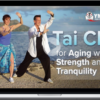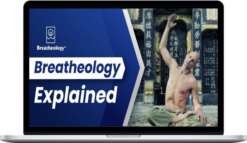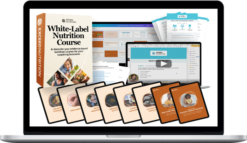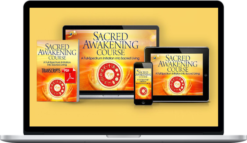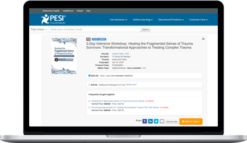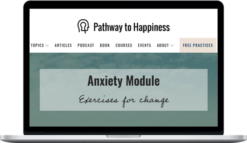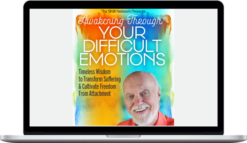Ken Cohen – Cultivate A Tai Chi Mind & Life
$297.00 $66.00
»Delivery: Within 24hs
Description
Ken Cohen – Cultivate A Tai Chi Mind & Life
Description Of Cultivate A Tai Chi Mind & Life
Study the ancient Chinese tradition of Tai Chi (‘medicine in motion’) with a renowned Grandmaster — and build a graceful, flowing practice that brings peace and wellbeing to your daily life.
Join us for an enlightening 7-part training with Ken Cohen, Tai Chi and Qigong Grandmaster and founder of the Qigong Research & Practice Center.
In The Cultivate A Tai Chi Mind & Life course, you’ll learn ancient techniques for harnessing the massive power of Qi, the vital breath and energy of the universe.
As the movements you learn from Ken Cohen build upon each other in each module, you’ll experience Tai Chi’s intricate choreography, bringing everything you’re learning into one seamless, accessible practice that you can easily return to anytime you’d like.
Ken Cohen, a world-renowned Tai Chi teacher with more than 50 years of experience, is beloved by students around the world for his friendly and energizing teaching style — and his way of making ancient healing arts easy to grasp and a joy to practice.
Ken Cohen teaches each movement slowly and carefully — with attention to every detail and plenty of time for review.
He’s taught more than 40,000 students and stays attuned to each group’s learning pace, slightly adjusting the number of moves as necessary. Each class will be formatted a little differently, customized to flow with the specific needs of you and your classmates.
In this 7-step online training, you’ll discover:
- How to build your own Tai Chi sequence to release tension, calm your mind, reconnect with the natural world, and cultivate joy
- How to relax deeply by “sinking” through your feet into the ground, like a tree with deep roots
- Ways to preserve the health of your joints and create more ease in movement
- The secrets of a stress-free, aligned posture — including correct weight distribution, releasing the shoulders, positioning the lower back and hips, and more
- The difference between fragmented power and whole-body power — and the secrets to conserving rather than wasting energy
- The benefits of maintaining postures as standing meditations — including increased strength, improved balance, and gentle joint stretching
- How yin and yang are more than philosophy — they’re guidelines for healthy living
- How Taoist philosophy enriches Tai Chi practice
- Feelings of unity, confidence, peace, and wellbeing through slow, deep Tai Chi breathing
- The powerful truths that slow movement is the basis of quick movement and relaxation builds inner strength
- The secrets of the 8 Core Tai Chi Skills, the basis of all Tai Chi forms
- Ways to harmonize mind (Yi), force (Li), and Qi (internal energy)
- How Tai Chi deepens your harmony with nature
- The fascinating connection between Tai Chi and energy medicine… and how practicing Tai Chi can help you become an energy healer
What You’ll Discover in These 7 Modules
In this 7-part transformational intensive, Ken Cohen will guide you through the fundamental body-mind-spirit skills and competencies you’ll need to successfully create your own Tai Chi practice — to lower anxiety, increase your vitality, cultivate joy, and move through life with greater physical ease.
This course will feature teachings, training sessions, and experiential practices with Ken Cohen. Each session will build harmoniously upon the previous ones, so you’ll develop a complete holistic understanding of the practices, tools, and principles you’ll need to cultivate a Tai Chi mind and life
What You’ll Learn In Cultivate A Tai Chi Mind & Life
Module 1: Introducing Tai Chi — Strong as the Mountain, Supple as Water (February 3)
Tai Chi arises from a boundless state of emptiness; it’s the mother of yin and yang.
— The Taiji Principle of Yin and Yang
A journey of a thousand miles begins with a single step. And as you begin your Tai Chi journey, this first step is important.
In this opening session, you’ll learn the foundational principles and first movements of Tai Chi.
You’ll discover the elements of Tai Chi posture — including simple ways to relax more deeply, the importance of bending your knees to put spring in your step, how to release constriction in your spine, and the role of your abdomen in deep breathing.
You’ll learn to step with the centered strength of a mountain, yet remain relaxed, balanced, and as supple as flowing water.
Most importantly, you’ll experience how meditative movement can empty the mind of worry and chatter.
For this opening class, the first 20 minutes will address frequently asked questions such as: What is Tai Chi? Is it a type of Qigong? What time of day should I practice? Does facing a certain direction enhance practice and enjoyment? Should I eat breakfast before or after practice? How can I combine Tai Chi with my workout at the gym?
Then you’ll move to the heart of the matter — practice. You’ll move through a Standing Meditation for grounding and building a reservoir of energy.
You’ll learn the first three movements of Tai Chi: Opening, Grasp the Sparrow’s Tail, and Ward-Off Left — and close class with a tranquil breath meditation.
In this session, you’ll discover:
- The inner meaning of Tai Chi and how it relates to Qigong
- How to relax deeply by “sinking” through your feet into the ground, like a tree with deep roots
- How the body can transform the mind
- Ways to preserve the health of your joints and create more ease in movement
- The secrets of a stress-free, aligned posture — including correct weight distribution, releasing the shoulders, positioning the lower back and hips, and more
- How to awaken your inner Tai Chi master as you practice the opening movements of Tai Chi
Module 2: Wu Wei — Effortless Action (February 10)
For this class, you’ll enjoy a traditional practice-based teaching.
You’ll begin by reviewing the Standing Meditation, using it to go more deeply into the elements of Tai Chi posture — standing like a tree with deep roots and tall branches that reach toward the sun.
Ken Cohen will guide you to review the first three movements of the Tai Chi form: Opening, Grasp the Sparrow’s Tail, and Ward-Off Left.
After several repetitions and some gentle corrections, you’ll continue with Ward-Off Right, Roll-Back, Press, and Push.
You’ll delve into the important principle of Zheng Ti Jin, Whole-Body Power — that the body is used in an integrated, connected fashion. The gentle, whole-body workout of Tai Chi is based on this powerful truth.
Another tenet of Tai Chi is, When one part moves, all parts move. In Taoism, this is called wu wei, the power of effortless action, or what is popularly known as “going with the flow.” Ken Cohen will show you how to apply this principle in everyday life so you can move more efficiently, accomplishing more with less force.
In this session, you’ll:
- Discover the difference between fragmented power and whole-body power — and the secrets to conserving rather than wasting energy
- Learn how Taoist philosophy enriches Tai Chi practice
- Discover the core movements of Tai Chi: Roll-Back, Press, and Push
- Explore the Single Whip movement, in which the arms and torso turn and wind gracefully like a flexible whip in slow motion
- Close your practice with a guided meditation on the body’s primary energy center in the lower abdomen — the dantian, known as “the field of the elixir of longevity”
- Ask Ken Cohen your questions during a 15-minute Q&A
Module 3: Coiling Silk — Unwinding Energy Knots (February 17)
During this class, you’ll review the Tai Chi techniques you’ve explored so far and learn details of the Single Whip, a posture noted for opening the joints and promoting free flow of Qi, life energy.
You’ll explore the Raise Hands movement, which may be held as a standing meditation to develop inner strength. From Raise Hands, you’ll flow into Kao, Shoulder Stroke, fine-tuning alignment so power moves through your whole body.
Then comes the beautiful White Crane Spreads Wing, inspired by everything the crane in nature and in Tai Chi teaches us about balance, alertness, and longevity.
In this session, you’ll:
- Practice and review movements including Single Whip, Raise Hands, Shoulder Stroke, and White Crane Spreads Wing
- Discover the benefits of maintaining postures as standing meditations — including increased strength, improved balance, and gentle joint stretching
- Learn the principle of Pulling Silk (gentle continuity) — and sense Tai Chi as a continuous, flowing river of silken energy, the Qi
- Apply the principle of Coiling Silk — turning and spiraling to dissolve tension and untie knotted energy
- Appreciate how Tai Chi can enhance your skill level in sports and athletic activities
- Practice all the movements from this session and previous classes, then move into 20 minutes of Q&A
Module 4: Storing & Releasing — The Yin & Yang of Tai Chi (February 24)
Tai Chi is often described as meditation in motion, but it might as well be called medication in motion.
— Harvard Medical School
During this class, you’ll move, as the Chinese say, from the skin to the bones, from surface to depth.
Ken Cohen will guide you to slowly and carefully review the Tai Chi form — with plenty of time devoted to the movements from the previous class.
You’ll continue with Brush Knee Twist Step, Play the Guitar, and a repetition of Brush Knee Twist Step. Brush Knee Twist step improves coordination and has a profound effect on brain health.
You’ll find a new level of inner balance by exploring the hidden dimensions of yin and yang in Tai Chi. And you’ll discover how some movements receive and store energy, putting you in a state of potential, or yin. Other movements, considered yang, give or release what’s been gathered.
Life requires both yin and yang. We can’t be always on, without a break or rest time. Nor can you find contentment if your resources and gifts are always held within and not expressed. Knowing how to store and release energy is the secret not only to Tai chi, but to a happy life.
In this session, you’ll:
- Accurately practice Brush Knee Twist Step and Play the Guitar movements
- Discover Tai Chi as a brain gym that develops and refines coordination skills
- Realize that yin and yang are more than philosophy — they’re guidelines for healthy living
- Learn new ways to coordinate your upper and your lower body, and your right side with your left side
- Explore the Tai Chi principle of Store and Release, and how to build a reservoir of energy and then express it — these are keys to personal wellbeing and balanced interactions with others
- Close with 20 minutes of Q&A and discussion
Module 5: Cultivating the Breath of Life (March 3)
Qi, life energy, develops naturally when you move in an aligned, relaxed, and fluid manner.
During this class, you’ll explore why Qi is linked with the breath, and you’ll learn the 4 Signs of Qi Activation: warmth, rootedness, vibration, and expansiveness.
As you’ll discover, healthy Tai Chi breathing moves both the diaphragm (lower abdomen) and the lower back, an area known as “the gate of life.”
Each breath massages the internal organs, reduces stress in the connective tissue, and helps restore balanced functioning.
Continuing with the Tai Chi form you’re building, you’ll review from the beginning as always — then add in new movements: Step, Parry, and Punch.
Ken Cohen will explain why Tai Chi includes slow-motion punches and is lauded as a superb martial art.
In this session, you’ll:
- Continue with the Tai Chi form, while slowing down the pace of learning to focus more on quality rather than quantity
- Get better and better at movements you learned in the earlier sessions, as they flow effortlessly from body memory
- Practice Tai Chi as meditation in motion, finding stillness in movement
- Experience how slow, deep Tai Chi breathing creates a feeling of unity, confidence, peace, and wellbeing
- Understand the powerful truths that slow movement is the basis of quick movement and relaxation builds inner strength
- Explore Ken’s presentation, A Brief History of Qi, where he’ll offer a dynamic commentary on the understanding of life energy among ancient cultures around the world, including the meaning of Qi in Tai Chi, shamanism, and modern medicine
Module 6: The 8 Core Skills of Tai Chi — Themes & Variations (March 10)
During this class, Ken Cohen will lead you to refine and correct all the movements you’ve learned in previous classes and add Withdraw and Push, as well as Cross Hands and Close.
You’ll discover how Tai Chi ends the way it began — with balance, stillness, and emptiness. The one produces the many, then the many return to the one.
After multiple repetitions, you’ll explore an essential, yet often-overlooked aspect of Tai Chi training, the Ba Shi, or 8 Core Skills.
As you’ll discover, every movement in every form of Tai Chi is based on the Ba Shi: Ward-Off, Roll-Back, Press, Push Down, Pluck, Split, Elbow, and Ram.
Once you understand these skills, you have an important key to improving your Tai Chi practice.
As you incorporate the Ba Shi into your practice, you take a significant step toward one of the goals of Tai Chi, called Dong Jin, or Comprehending Internal Energy. To Dong Jin is to become a more empowered and alive human being.
In this session, you’ll:
- Review, refine, and correct previously learned movements
- Complete your Tai Chi short form by learning Withdraw and Push & Cross Hands and Close
- Discover how practicing Tai Chi is like performing music — the slow movement (andante) is the most difficult, and there is delight in practicing variations on familiar themes
- Learn the secrets of the 8 Core Skills, the basis of all Tai Chi forms
- Explore how the 8 Core Skills can train your body and mind to function more efficiently and friction-free in everyday life — and help you discover strength and inner resources you didn’t know you had
Module 7: The Journey Begins — In a Circle, the End Is the Beginning (March 17)
To travel hopefully is better than to arrive.
— Robert Louis Stevenson
In this final class, Ken Cohen will lead you through a grand review of every movement and detail in your Tai Chi form.
You’ll feel the powerful truth that there’s never an end point, because there’s always room for improvement and greater enjoyment.
You’ll learn various ways of practicing the form: slowly and fluidly, like pulling a silk thread from a cocoon, or just a bit more quickly so you can feel the momentum generated by the shift of the weight and the turn of the waist.
Ken Cohen will guide you to feel the flow of Qi in your body as you practice. Or you might prefer to visualize your practice as being supple as water, rooted as a pine tree, and elegant as a crane.
He’ll also introduce and demonstrate how the various postures may be used in energy medicine to remove obstructions and transmit healing energy to a client… perhaps the most hidden aspect of Tai Chi.
In this session, you’ll:
- Review every detail of the entire form you’ve learned
- Harmonize mind (Yi), force (Li), and Qi (internal energy)
- Experience how Tai Chi deepens your harmony with nature
- Learn about the fascinating connection between Tai Chi and energy medicine, and how practicing Tai Chi can help you become an energy healer
- Explore ways to continue improving the quality and joy of your practice
- Enjoy a closing 20-30 minutes of Q&A and a tranquil seated meditation
About Ken Cohen
Kenneth S. Cohen (Gao Han), MA, is a world-renowned Tai Chi and Qigong Grandmaster with more than 50 years of experience. A former collaborator with Alan Watts, he’s the author of the internationally acclaimed book, The Way of Qigong, and more than 200 journal articles on spirituality and health. Ken Cohen received his teaching certificate from the William C. C. Chen School of Tai Chi Chuan in 1974 and continued training with B. P. Chan and Madame Gao Fu. He eventually became the apprentice of Taoist Abbot Huang Geng Shi (1910-1999), an acupuncturist, Qi healer, and martial artist from China’s sacred Xi Qiao Mountain.
A leader in the dialogue between ancient wisdom and modern science, Ken Cohen was one of the first to teach Qigong in North American medical schools. His sponsors have included the Mayo Clinic, the Menninger Institute, the American Cancer Society, and numerous cultural organizations. He is the recipient of the Alyce and Elmer Green Lifetime Achievement Award in Energy Medicine. Ken is known for his friendly and engaging teaching style, making ancient healing arts easy to understand and a joy to practice.
More courses from the same author: Ken Cohen
Delivery Policy
When will I receive my course?
You will receive a link to download your course immediately or within 1 to 21 days. It depends on the product you buy, so please read the short description of the product carefully before making a purchase.
How is my course delivered?
We share courses through Google Drive, so once your order is complete, you'll receive an invitation to view the course in your email.
To avoid any delay in delivery, please provide a Google mail and enter your email address correctly in the Checkout Page.
In case you submit a wrong email address, please contact us to resend the course to the correct email.
How do I check status of my order?
Please log in to HealingCourse account then go to Order Page. You will find all your orders includes number, date, status and total price.
If the status is Processing: Your course is being uploaded. Please be patient and wait for us to complete your order. If your order has multiple courses and one of them has not been updated with the download link, the status of the order is also Processing.
If the status is Completed: Your course is ready for immediate download. Click "VIEW" to view details and download the course.
Where can I find my course?
Once your order is complete, a link to download the course will automatically be sent to your email.
You can also get the download link by logging into your HealingCourse account then going to Downloads Page.
Related products
Total sold: 3

